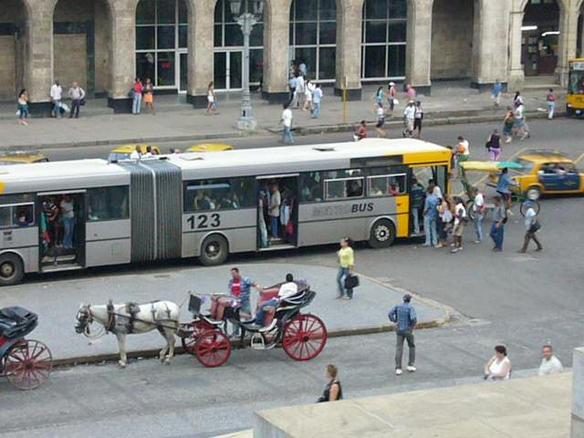
It takes Esteban, 43 years old, four hours every day for the round trip to his job on the outskirts of Havana. Around 7 am, along with a bunch of people, he tries to board the P-8 bus on the Acosta P-8 and Calzada 10 de Octubre line.
“For several months, the city bus service has taken a dive. I don’t know why. Every day going to work is a disaster,” he points out, sweating after running 60 meters to catch a bus that paused beyond the bus stop.
In Cuba, the only means of cheap public mass transit are the city buses (they cost less than a nickel U.S.). State taxi service has disappeared. It’s a fleet of Ladas manufactured in the mid-80’s in Russia.
These cars have seen 20 to 25 years of service and generally are in poor technical condition. The state has leased them to the drivers, who must pay for repairs and extra fuel after serving half a day providing assistance to hospitals, funeral homes and air terminals.
The fee is ten pesos (0.50 U.S. cents, the average salary for a day), the same as private taxis. But there are very few Ladas in service. And it doesn’t occur to anyone who uses public transport to spend part of his daily wage to get to work on time.
So the only option is the bus. In 2008 the government bought around 750 buses from China, Russia and Belarus to improve the disastrous service in the capital. It designed a main line of 17 routes identified with the letter P, which usually run along the main thoroughfares of the city.
These buses are articulated and initially arrived every 5 to 10 minutes during peak hours. There was also a support network of buses, to transport people to the inner neighborhoods and suburban areas, where the main lines often did not go. They have the letter A and run every 25 minutes.
But by mid-2009, with the policy of conserving fuel and tightening the screws on the local economic crisis, they stopped purchasing the buses, and improvements in the quality of urban transport suffered a setback.
Everything went to hell. In December 2010, the situation became precarious. Media predictions of half a million people unemployed prompted an increase in the number of people taking the bus every day.
At all hours the bus stops are filled with people who are anxious and desperate to get to their destinations. The main lines like the P-12 or the P-16 can take up to 45 minutes to arrive.
The frequency of the rest of the P line has also deteriorated. And this leads to overcrowded buses all day. Alberto, an employee of the company Metrobus, which is in charge of transportation in Havana, asserts that more than 80 buses are out of service. “For lack of financing and debts with China and Russia, it hasn’t been possible to get batteries, tires and other essential parts for the maintenance of these vehicles,” he points out.
Given this reality, habaneros like Esteban will have to keep suffering every morning to try to get to work on time. The same as with most economic sectors on the island, investments in urban transport are paralyzed. Until further notice.
Photo: Martijn Vrenssen
Translated by Regina Anavy
January 28 2011
